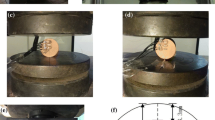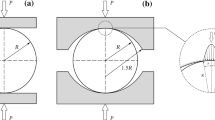Abstract
Indirect tension tests using Brisbane tuff Brazilian disc specimens under standard Brazilian jaws and various loading arcs were performed. The standard Brazilian indirect tensile tests caused catastrophic, crushing failure of the disc specimens, rather than the expected tensile splitting failure initiated by a central crack. This led to an investigation of the fracturing of Brazilian disc specimens and the existing indirect tensile Brazilian test using steel loading arcs with different angles. The results showed that the ultimate failure load increased with increasing loading arc angles. With no international standard for determining indirect tensile strength of rocks under diametral load, numerical modelling and analytical solutions were undertaken. Numerical simulations using RFPA2D software were conducted with a heterogeneous material model. The results predicted tensile stress in the discs and visually reproduced the progressive fracture process. It was concluded that standard Brazilian jaws cause catastrophic, crushing failure of the disc specimens instead of producing a central splitting crack. The experimental and numerical results showed that 20° and 30° loading arcs result in diametral splitting fractures starting at the disc centre. Moreover, intrinsic material properties (e.g. fracture toughness) may be used to propose the best loading configuration to determine the indirect tensile strength of rocks. Here, by using numerical outcomes and empirical relationships between fracture toughness and tensile strength, the best loading geometry to obtain the most accurate indirect tensile strength of rocks was the 2α = 30° loading arc.










Similar content being viewed by others
Abbreviations
- ISRM:
-
International Society for Rock Mechanics
- UCS:
-
Uniaxial compressive strength test
- BTS:
-
Brazilian tensile strength
References
Alkilicgil C (2010) Development of specimen geometries for mode I fracture toughness testing with disc type rock specimens. PhD thesis, Middle East Technical University, Ankara
Blair SC, Cook NGW (1998) Analysis of compressive fracture in rock using statistical techniques Part I: A non-linear rule-based model. Int J Rock Mech Min Sci 35(7):837–848
Cai M, Kaiser PK (2004) Numerical simulations of the Brazilian test and tensile strength of anisotropic rocks and rocks with pre-existing cracks. Int J Rock Mech Min Sci 4:478–483
Erarslan N (2011) Static and cyclic laboratory testing of Brisbane rocks, The University of Queensland, Brisbane
Fairhurst C (1964) On the validity of the ‘Brazilian’ test for brittle materials. Int J Rock Mech Min Sci 1:535–546
Griffith AA (1920) The phenomena of rupture and flow in solids. Phil Trans R Soc Lond A221:163
Guo H, Aziz NI, Schimidt LC (1993) Rock fracture toughness determination by the Brazilian test. Eng Geol 33:177–188
Hondros G (1959) The evaluation of Poisson’s ratio and the modulus of materials of a low tensile resistance by Brazilian (indirect tensile) test with particular reference to concrete. Aust J Appl Sci 10:243–268
Hudson JA, Brown ET, Rummel F (1972) The controlled failure of rock discs and rings loaded in diametral compression. Int J Rock Mech Min Sci 9(2):241–244
ISRM (1995) Suggested method for determining mode I fracture toughness using cracked chevron notched Brazilian disk (CCNBD) specimens. Int J Rock Mech Min Sci Geomech Abstr 32(1):57–64
ISRM (2007) Suggested methods for determining tensile strength of rock materials. In: Ulusay R, Hudson JA (eds) The complete ISRM suggested methods for rock characterization, testing and monitoring: 1974–2006, pp 177–184
Jaeger JC, Cook NGW (1976) Fundamentals of rock mechanics. Chapman and Hall, London
Jaeger JC, Hoskins ER (1966) Stresses and failure in rings of rock loaded in diametral tension or compression. Brit J Appl Phys 17:685–692
Lanaro F, Sato T, Stephansson S (2009) Microcrack modelling of Brazilian tensile tests with the boundary element method. Int J Rock Mech Min Sci 46:450–461
Liu H (2004) Numerical modelling of the rock fragmentation process by mechanical tools. PhD thesis, Luleå University of Technology, Luleå, Sweden
Markides CF, Pazis DN, Kourkoulis SK (2010) Closed full-field solutions for stresses and displacements in the Brazilian disk under distributed radial load. Int J Rock Mech Min Sci 47:237–247
Mellor M, Hawkes I (1971) Measurement of tensile strength by diametral compression of discs and annuli. J Eng Geol 5:173–225
Schlangen E, Garboczi EJ (1997) Fracture simulations of concrete using lattice models: computational aspects. Eng Fract Mech 57:319–332
Tang CA, Fu YF, Kou SQ, Lindquist PA (1998) Numerical simulation of loading inhomogeneous rocks. Int J Rock Mech Min Sci Geomech Abstr 35:1001–1007
Van de Steen B (2001) Effect of heterogeneities and defects on the fracture pattern in brittle rock. PhD thesis, Katholieke Universiteit Leuven, Leuven, Belgium
Van de Steen B, Vervoort A, Napier JAL (2005) Observed and simulated fracture pattern in diametrically loaded discs of rock material. Int J Fract 131:35–52
Wang QZ, Xing L (1999) Determination of fracture toughness KIC by using the flattened Brazilian disk specimen for rocks. Eng Fract Mech 64:193–201
Whittaker BN, Singh RN, Sun G (1992) Rock fracture mechanics: principles, design and applications. Elsevier, Amsterdam
Yu Y, Zang JX, Zang J (2009) A modified Brazilian disc tension. Int J Rock Mech Min Sci 46:421–425
Acknowledgments
Acknowledgement is made to Leighton Contractors, who provided core samples of Brisbane tuff from the CLEM7 Project, and to Professor Ted Brown AC, Les McQueen, Mark Funkhauser and Rob Morphet of Golder Associates Pty Ltd for their assistance and advice. The work described forms part of the first author’s PhD research carried out at the Golder Geomechanics Centre at The University of Queensland. The first author was supported by an Australian Postgraduate Award/UQRS and the Golder Geomechanics Centre.
Author information
Authors and Affiliations
Corresponding author
Rights and permissions
About this article
Cite this article
Erarslan, N., Liang, Z.Z. & Williams, D.J. Experimental and Numerical Studies on Determination of Indirect Tensile Strength of Rocks. Rock Mech Rock Eng 45, 739–751 (2012). https://doi.org/10.1007/s00603-011-0205-y
Received:
Accepted:
Published:
Issue Date:
DOI: https://doi.org/10.1007/s00603-011-0205-y




